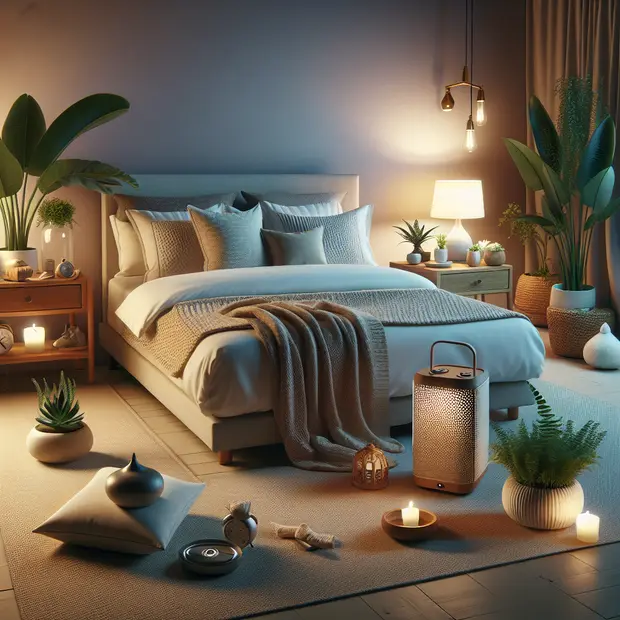How to Make Your Bedroom a Sleep Sanctuary
This article provides an in-depth guide on transforming your bedroom into a sleep sanctuary for improved sleep. It explores evidence-based tips such as decluttering, color selection, investing in a quality mattress, controlling lighting, noise and temperature, and limiting screen time.

Are you struggling to catch those precious Z's at night? You're not alone. The Centers for Disease Control and Prevention reports that one in three adults doesn't get enough sleep. But fret not, the solution may just be a few steps away, right in your own bedroom. Welcome to the journey of transforming your bedroom into a sleep sanctuary!
A Sanctuary of Serenity: The Impact of Your Bedroom Environment
In the fascinating world of sleep science, the environment in which we rest plays a significant, often underrated role in determining the quality of our slumber. A groundbreaking study published in the esteemed Journal of Physiological Anthropology has shed light on the paramount influence that environmental factors hold over our overall sleep health.
It becomes increasingly important then, to pay close attention to our bedrooms - a space where we spend a substantial portion of our lives in repose. After all, it isn't merely a room, but a personal sanctuary where we recharge, rejuvenate and prepare for the challenges of the forthcoming day.
Consider this: when we think of a bedroom, we see a reflection of our personality, our tastes, and preferences. However, beyond the aesthetics and personalization, it is our subconscious retreat, acting as a soothing salve on the day’s stresses and silently improving our health and wellbeing. Therefore, the role it plays in enhancing the quality of our sleep is of paramount importance.
A clutter-free, serene environment could be the key to unlocking a better night's sleep and by extension, a healthier life. It could be the room’s layout, the colors on the walls, the temperature settings, the level of external noise - each of these elements contributes to creating a harmonious environment conducive to restful sleep.
So, let's explore further. How can we optimize our bedrooms to foster an environment of calmness and tranquility? Stay tuned as we dive deep into understanding this intriguing intersection of sleep science and our immediate environment.
Declutter Your Space: Your First Step towards Tranquility
Our journey to a tranquil environment kicks off with a crucial step - decluttering. Have you ever found yourself overwhelmed by the chaotic energy a cluttered space emits? It's not just an unpleasant sight; clutter has proven psychological implications too. A ground-breaking study spearheaded by the Princeton University Neuroscience Institute discovered a fascinating correlation between physical clutter and mental disarray. The results revealed that physical clutter is more than just an eyesore - it actively competes for your attention, inevitably leading to compromised performance and a significant upsurge in stress levels.
So, where should you begin? A wise place to start would be your very own bedroom. This sacred space where you unwind and rejuvenate should reflect peace and simplicity. Start the decluttering process by identifying and removing non-essential items that take up unnecessary space. This can be anything from redundant furniture pieces to old magazines gathering dust. Belongings that no longer serve a purpose or bring joy should be the first to go. If you haven't used an item in a long time and it doesn't hold sentimental value, it's a candidate for decluttering.
Post purge, take a moment to absorb the difference. With every discarded item, you are not just creating a physical space but mental space as well. An uncluttered bedroom is more than just aesthetically appealing; it is the starting point of an environment that breathes simplicity and tranquility. It is the stepping stone towards a clutter-free mind and a serene living space. Ridding your space of clutter is indeed a transformative experience. So, embark on this journey of decluttering and embrace the tranquility that comes with simplicity.
Choose Your Colors Wisely for a Harmonious Environment
When it comes to crafting a space that resonates with tranquility and calm, choosing your colors wisely is of paramount importance. It's an acknowledged fact that colors have a profound influence on our physiological responses, and being mindful of this can help us create an environment that fosters well-being and peace.
The color blue, for instance, has been linked to a lowered heart rate and decreased blood pressure. It's a hue that is often associated with the serenity of a cloudless sky or the gentle waves of a tranquil sea. If you're looking to design a bedroom that serves as a sleep sanctuary, blue can be an ideal choice. Incorporating this calming color in your decor can promote relaxation and help you drift into a peaceful slumber after a long day.
On the flip side, there are colors that can stimulate energy and evoke a sense of vitality. Vibrant shades like red and violet are known to invigorate the senses and awaken the mind. However, because these colors have a stimulating effect, they should be used sparingly and thoughtfully. They can be great for areas where you want to inspire creativity or activity, but less suitable for spaces meant for unwinding and relaxation.
Remember that color is a powerful tool in creating an atmosphere that suits your needs and preferences. However, balance is crucial - overuse of energizing colors can lead to restlessness, while too much of calming colors can result in a lack of motivation. So, consider your color choices wisely to create a space that is harmonious and conducive to your well-being.
Invest in a Good Quality Mattress
The National Sleep Foundation strongly advocates for investing in a top-notch, comfortable, and supportive mattress. This is not a matter to be taken lightly; your choice of mattress can significantly influence the quality of your sleep.
It is essential to choose a mattress that supports your body type and sleeping posture. Just like we all have unique fingerprint, our sleeping preferences and comfort levels are also unique. One size does not fit all in the case of mattresses.
Consider factors such as your weight, height, and whether you sleep on your side, back, or stomach. These elements can help you determine what firmness and support you need from your mattress.
Moreover, it's not just about comfort. A good-quality mattress can also help to prevent back problems and other health issues that can arise from poor sleep posture.
Don’t compromise on your sleep quality; after all, we spend nearly a third of our lives sleeping! Make the smart choice and invest in a high-quality mattress that best suits your needs. Remember, a good night’s sleep starts with a good mattress.
Take Control of Your Lighting
One often-overlooked factor that significantly impacts our sleep quality is our exposure to light. Light exposure plays a vital role in influencing our circadian rhythm, our body's internal clock that orchestrates sleep and wake cycles. By regulating the type and amount of light we expose ourselves to, we can have a considerable impact on our sleep patterns.
As the evening sets in, it is a good practice to limit your exposure to bright light. This is because our bodies associate bright light with daytime, which can interfere with the body's natural preparation for sleep. Hence, it is advisable to dim the lights in your living space, especially in your bedroom, a few hours before your bedtime. Opting for soft or warm lighting can help create a soothing atmosphere conducive to relaxation and sleep.
Furthermore, investing in certain items can help curtail external light sources, providing a darker environment that is ideal for sleep. Blackout curtains are an excellent investment for this purpose. They can effectively block out any external light from streetlights or passing cars that could potentially disrupt your sleep. If you're someone that travels frequently or if your sleeping environment cannot be completely dark, an eye mask can be a very useful tool. It provides a portable solution to block out light, ensuring that your sleep environment remains consistently dark, regardless of where you are.
In conclusion, taking deliberate control of your lighting can help align your body's circadian rhythm, assist in creating a calming sleep environment, and ultimately lead to better sleep quality. So, make the strategic lighting choices today for healthier and more restful sleep tonight.
Keep the Noise Down for a Peaceful Slumber
Unwanted noise, from blaring car horns to incessant dog barking, can significantly disrupt your sleep. If you find yourself constantly waking up due to these external noises, then it might be time to take action.
One effective solution is to consider using earplugs. Earplugs, when properly inserted, can greatly reduce noise levels and block out the majority of unwanted sounds. They're easy to use, portable, and can make a noticeable difference in your sleep quality.
Another alternative is the use of a white noise machine. White noise machines work by creating a consistent soothing sound that masks other noises. This can be particularly helpful for those who live in busy cities or noisy neighborhoods. The consistent, ambient sound produced by these machines not only helps to drown out external noise but can also create a calming environment that promotes better sleep.
Alternatively, a fan can serve a dual purpose. Not only can a fan help to cool down your bedroom, which is beneficial for sleep, but the sound it generates can also mask unwanted noise. It's a simple and cost-effective solution for those looking for ways to improve their sleep environment.
Remember, a quiet and peaceful environment is key to obtaining a restful night's sleep. So consider these options and choose what works best for your needs. After all, we all deserve a good night's sleep, don't we?
The Importance of Temperature for Quality Sleep
Did you know that the temperature of your bedroom plays a crucial role in determining the quality of your sleep? The National Sleep Foundation suggests that maintaining a bedroom temperature of around 65 degrees Fahrenheit (18.3 degrees Celsius) is ideal for optimal sleep. This might seem a bit cool, but it's all about creating the ideal environment that allows your body to relax and rest.
When you sleep, your body’s internal temperature decreases, and a cooler bedroom can aid this natural process. If your room is too hot or too cold, it can interfere with this natural temperature drop and disrupt your sleep patterns. This could lead to you waking up in the middle of the night, reducing the overall quality of your sleep.
Of course, the "perfect" temperature can vary from person to person. It's also dependent on other factors such as the quality of your mattress, bedding, and sleepwear. However, the general consensus amongst sleep experts is that a cooler room, around the 65 degrees Fahrenheit mark, promotes a better, more restful sleep.
By controlling the temperature in your bedroom, you can create a sleep-friendly environment. So, try adjusting your thermostat tonight to see if you notice any improvements in your sleep quality. And remember, good sleep is not just about duration but also about quality.
Limit Screen Time
It's tempting to watch one more episode of your favorite show or check your social media before bed. But the blue light emitted by electronic devices can mess with your sleep. Try to limit screen time at least an hour before bed.
Transforming your bedroom into a sleep sanctuary is not about following a rigid set of rules. It's about creating an environment that supports your unique sleep needs. Remember, every step you take towards this journey is a step towards better health and wellbeing.
🌿
Category: Sleep Improvement
Join the community
Related Articles

Creating a Sleep Sanctuary: Tips for a Comfortable Sleep Environment
When the world around us becomes too loud, too demanding, an...

Strategies for Improving Sleep Duration and Quality
We all know the importance of a good night’s sleep. Not on...

The Science of Sleep: How to Improve Your Sleep Quality for Better Health
Sleep is one of the most important aspects of overall he...
Latest Articles

The Role of Minerals in Rock Formation
Welcome to another enlightening article on HeavenRelax.com, ...

The Importance of Patience in Our Life
In this fast-paced world we live in, patience is often seen ...

Importance of Patience in Customer Service
Are you ever lost for words when a customer complaint spiral...
Comments
No comments yet. Be the first to comment!